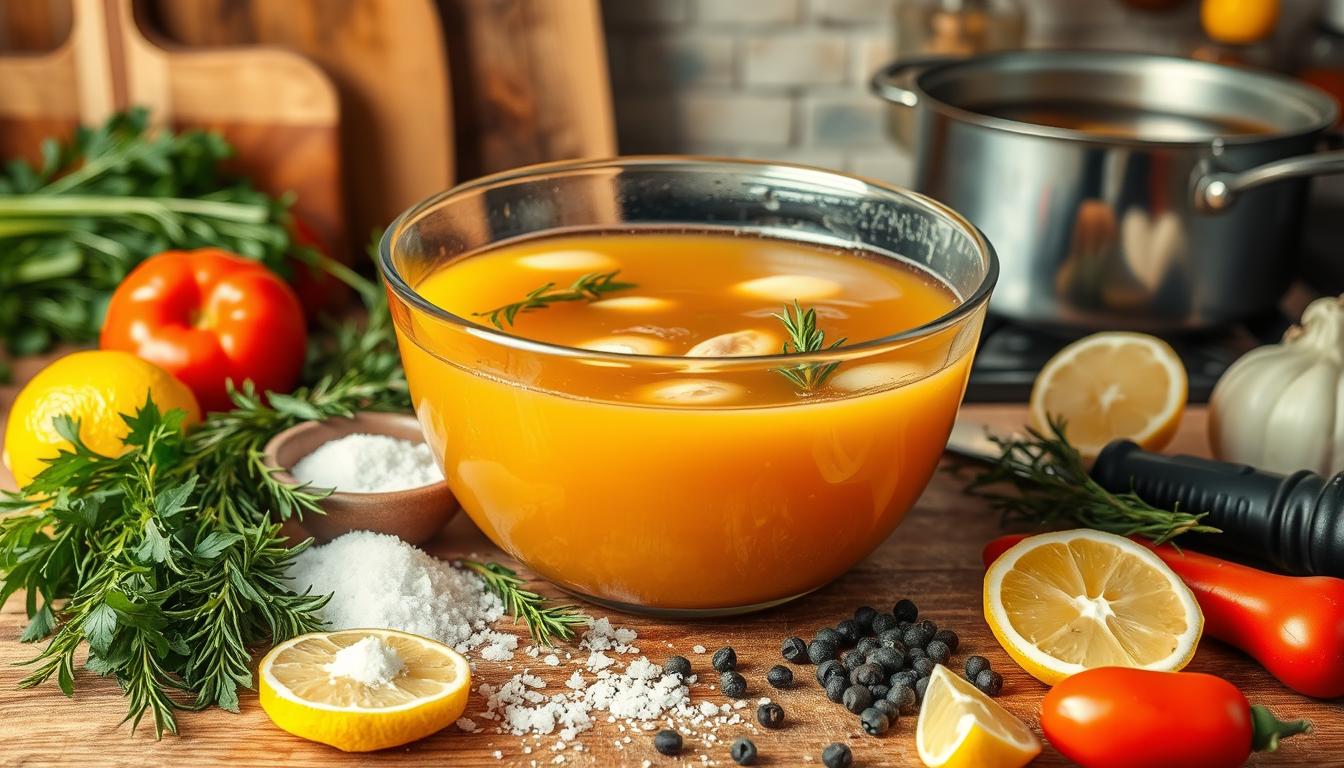What is brining chicken? As a busy parent, I’m always looking for ways to make my chicken dishes better. That’s why I was excited to learn about brining . a simple yet powerful technique that can make your chicken incredibly delicious. Let me tell you how I discovered the magic of brined chicken and how it can improve your cooking.
Key Takeaways
- Brining is the process of soaking chicken in a salt water solution to enhance moisture, tenderness, and flavor.
- The optimal brining time for chicken breasts is 30 minutes to 1 hour, with cold water being more effective than warm water.
- A basic brine recipe consists of 4 cups of cold water and 4.5 tablespoons of Morton’s kosher salt or 3 tablespoons of fine salt.
- Brining can be done with a variety of seasonings and aromatics to further boost the flavor profile.
- Brined chicken can be frozen for up to 6 months, retaining its juiciness and tenderness.
Understanding the Science of Brining
Brining makes chicken juicier and tastier. But how does it work? Learning about brining’s science can help you make your chicken dishes even better.
Osmosis and Salt Penetration
Osmosis is key in brining. When chicken is in saltwater, salt goes into the meat. This brings water into the meat, making it juicy.
Chemical Changes in Meat Structure
Salt in the brine softens chicken’s tough fibers. It changes the meat’s protein structure, making it tender and juicy.
Impact on Protein Molecules
Brining changes chicken’s protein molecules too. Salt in the brine tightens these molecules. This helps chicken stay moist and flavorful.
Knowing brining’s science lets you make chicken moist and tasty every time. It’s great for simple meals or big feasts. Your guests will love it.
What Is Brining Chicken: A Complete Guide
Brining chicken is a simple yet effective technique. It can turn a basic chicken dish into a juicy, flavorful masterpiece. This process involves submerging the chicken in a saltwater solution. The meat absorbs moisture and seasoning for optimal taste and texture.
The key to successful brining lies in understanding the science behind it. Brining uses the principles of osmosis. The salt in the solution penetrates the meat, altering the protein structure and retaining moisture during cooking. This results in chicken that is exceptionally tender, juicy, and infused with delightful flavors.
The Brining Process
To brine chicken, you’ll need to prepare a saltwater solution, also known as a brine. The standard ratio is 1 tablespoon of kosher salt per cup of water. You can customize the strength to match your taste preferences. Immerse the chicken, whether it’s a whole bird or individual cuts, in the brine and refrigerate for the recommended time:
- Whole chicken: 8-24 hours
- Bone-in chicken pieces: 4 hours
- Boneless chicken pieces: 2 hours
During this time, the chicken will absorb the salt and moisture. This leads to a more flavorful and tender outcome.
Flavor Enhancers
To take your brined chicken to the next level, consider adding aromatic ingredients to the brine. Some options include:
- Citrus fruits (lemon, orange, lime)
- Herbs (rosemary, thyme, parsley)
- Spices (peppercorns, bay leaves, garlic)
- Sweeteners (honey, brown sugar)
These additions can infuse your chicken with a wide range of flavors. From savory to sweet, they elevate the overall dining experience.
Brining chicken is a simple yet effective way to ensure your poultry is juicy, tender, and bursting with flavor. By understanding the science behind the process and experimenting with various brine ingredients, you can create a truly exceptional chicken dish. This dish will definitely impress your family and friends.
Essential Ingredients for Perfect Chicken Brine
Making the perfect chicken brine starts with knowing the key ingredients. Water and salt are the basics that add flavor and moisture. Use kosher or sea salt for the best results because their crystals dissolve well.
Types of Salt and Their Effects
The salt you pick matters a lot. Kosher salt’s big flakes help the brine get into the chicken better. This makes the chicken juicier and tastier. But, Morton’s salt can make it too salty if not used carefully. Fine table salt should be used little because it can overpower other flavors.
Optional Aromatics and Seasonings
Adding aromatics and seasonings can make your brine better. Fresh herbs like rosemary, thyme, and sage add great flavor. So are whole spices like peppercorns and bay leaves. Garlic and onion add their own special tastes. These extras make your chicken smell and taste amazing.
Water Temperature Considerations
For the water, cooler is better. Use cold or ice-cold water. Warm or hot water can make the chicken dry and tough. Cold water helps the brine get into the chicken better, making it moist and tender.
Learning about the essential ingredients will help you make the best brine for chicken. It will take your chicken brine recipe to the next level.
Wet Brine vs Dry Brine Methods
Both wet brining and dry brining can make chicken taste better and stay moist. Wet brining involves immersing the chicken in a saltwater mixture. Dry brining uses a dry salt mix on the meat.
Wet brining works well for short times because the chicken soaks up flavors and moisture fast. You mix water, salt, sugar, and spices like herbs and garlic into the brine. Let the chicken soak in the brine for a few hours to a couple of days.
Dry brining is easier, especially for big chicken pieces. You just salt the meat heavily and chill it uncovered for at least 12 hours. The salt pulls out moisture, then the meat absorbs it back, making it juicy and flavorful.
Choosing between wet and dry brining depends on what you like, how much time you have, and the chicken type. Wet brining adds strong flavors, while dry brining makes the meat crispy. Experiment with both techniques to find your favorite.

“Brines work best with lean meats that tend to dry out, such as pork, chicken, fish, and turkey.”
The Perfect Brine Solution Ratio
Finding the right balance is key to making the perfect chicken brine. The best ratio is 4 cups of cold water to 4.5 tablespoons of Morton’s kosher salt or 3 tablespoons of fine salt. This mix enhances flavor without making the chicken too salty.
Basic Brine Formula
To create a basic chicken brine, mix these ingredients in a large container:
- 4 cups of cold water
- 4.5 tablespoons of Morton’s kosher salt or 3 tablespoons of fine salt
Stir until the salt dissolves. Then, you’re set to brine your chicken. This formula keeps your meat juicy and full of flavor.
Seasoning Measurements
Want to elevate your chicken brine? Add 1 tablespoon of garlic granules or other seasonings. This step adds delicious flavors that enhance the chicken’s natural taste.
You can tweak the brine ratio to make it stronger or lighter. Just remember, too much salt can ruin the chicken’s texture and taste.
“The perfect brine strikes a delicate balance between enhancing the natural flavors of the chicken and preventing it from becoming overly salty.”
With this chicken brine recipe and the right best brine for chicken, you’re on your way to juicy, flavorful chicken every time.
Optimal Brining Times for Different Cuts
Brining makes chicken moist and flavorful. But, timing is everything. The brining time affects the chicken’s texture and taste. Let’s explore the best brining times for different cuts of chicken.
Boneless, skinless chicken breasts do well with a 30-minute to 1-hour brine. This short time keeps the meat juicy and adds a hint of flavor.
Chicken thighs and drumsticks need 2 to 4 hours in the brine.This ensures the flavors are absorbed more fully into the meat. It’s great for the tougher parts of the chicken.
A whole chicken should brine for 8 to 12 hours. This long soak ensures every part of the chicken is seasoned and juicy.
Be careful not to overbrine your chicken.It can lead to meat that is too salty and overly soggy. Even a quick 15-minute brine can help, but longer times are better for flavor and texture.
Adjusting the chicken brine time based on the cut is key. This way, your how to brine chicken efforts will always pay off with a delicious dish.

Common Brining Mistakes to Avoid
Brining chicken can make a big difference, turning it from dry to moist and flavorful. But, there are mistakes to watch out for to get it just right. These include oversalting and temperature issues. Let’s look at how to avoid these for the best brined chicken.
Oversalting Prevention
One big mistake is using too much salt. Salt is key in brining, but too much makes the chicken too salty. To avoid this, stick to the recommended salt ratio and brining times. Rinsing and drying the chicken before cooking also helps remove excess salt.
Temperature Control Issues
Keeping the brine at the correct temperature is crucial for safety. It should be between 35°F and 40°F. Letting it get too warm can lead to harmful bacteria growth. Use a thermometer to check the temperature and keep it cold in the fridge or a cooler with ice.
Time Management Errors
Brining for too long can make the chicken too salty and mushy. Stick to the recommended times, usually 8-12 hours for a whole bird or 2-4 hours for breasts. Brining too long can ruin the chicken’s texture and taste. Set a timer and take the chicken out of the brine when time’s up.
Avoiding these mistakes will help you achieve perfectly moist and flavorful chicken every time. Just remember to watch the salt, temperature, and brining time for the best results.
Storage and Food Safety Guidelines
When how to brine chicken, keeping it refrigerated is key. After brining, store the chicken in the fridge for up to 3 days before cooking. You can also keep it frozen for up to 2 months. Always cook chicken to 165°F to kill bacteria.
Always use separate tools and surfaces for raw and cooked chicken to avoid contamination.
Storing brining chicken benefits right is vital for quality and safety. Brined chicken stays fresh in the fridge for 3-4 days. For longer, freeze it for up to 9-12 months in a sealed container or bag at 0°F (-18°C).
Remember, cook brined chicken to 165°F (74°C) to ensure safety and kill bacteria.
Good food handling is essential with brined chicken. Be sure to clean your hands thoroughly before and after touching raw chicken to avoid contamination. Use separate cutting boards and utensils for raw and cooked chicken to prevent contamination. Thaw frozen chicken in the fridge to keep it safe.
FAQ
What is brining chicken?
How does brining work?
What are the benefits of brining chicken?
What are the basic ingredients needed for a chicken brine?
What is the distinction between wet brining and dry brining?
What is the ideal brine solution ratio?
How long should I brine chicken?
What are common brining mistakes to avoid?
How should I store and handle brined chicken?
What did you think of our recipe?
There are no reviews yet. Be the first one to write one.

